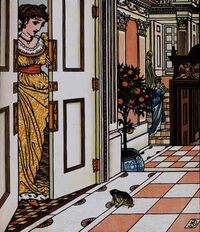
1874 illustration for "The Frog King" by Walter Crane.
"The Frog King, or Iron Henry" (German: "Der Froschkönig oder der eiserne Heinrich"), also known in English as "The Frog Prince", is a fairy tale collected in the first volume of Children's and Household Tales (Kinder- und Hausmärchen) by the Brothers Grimm which was first published in 1812. According to the Grimms, "The Frog King" is one of the oldest German folk tales.
In the story, a princess promises a frog that she will make him her companion if he retrieves her favorite toy from the bottom of the deep spring. When the frog comes to visit her later, however, she is terrified by the revolting appearance of the creature. Commanded by her father to keep her promise, the princess reluctantly invites the frog into the castle.
"The Frog King" has been adapted to other media many times.
Plot[]
A king with beautiful daughters lives in a castle near a forest. The youngest daughter, who is extraordinarily beautiful, likes to play and sit beside the spring in the forest. One day, the princess' favorite plaything, a golden ball, rolls into the spring. The water is too deep for the princess, and she begins to cry over the lost toy.

1912 illustration by Robert Anning Bell.
A frog sticks his head out of the water and asks the princess why she is crying. The princess tells the frog about the golden ball. The frog says to the princess that, if she will promise to love him and let him be her companion, he will dive down and retrieve the ball for her. The princess promises, but she thinks to herself that the frog is so ugly that no one can possibly love it. When the frog brings back the golden ball, she is so overjoyed that she runs back home with the ball, completely forgetting about the poor frog.
The next day at dinner time, the frog comes to the castle door and asks to be let in. The princess, terrified at the sight of the disgusting frog, slams the door. The king asks her what has scared her. She tells him about the frog and the promise she made. The king tells her that she must keep her promise, so the princess reluctantly opens the door.
The frog follows the princess back to the dining room and asks to be put on the table so he can eat off her plate. The princess, commanded by her father, unhappily shares the meal with the revolting creature. After the meal, the frog asks to be taken to the princess' room so he can sleep on her bed. She begins to cry, but her father scolds her and tells her that she must be nice to someone who helped her. Although she does not want to touch the frog, she does as she is told and takes it to her bedroom.
When the frog asks her to lift him up into her bed, the princess becomes angry and throws him hard against the wall. As the frog falls to the ground, it turns into a handsome prince.[1] A witch had cast a spell on him, and only a princess could release him. The king gives them his blessing, and the prince marries the princess.
The happy couple travel to the young king's kingdom accompanied by his faithful servant Henry. Henry had been so grieved by the transformation of his master that he had three iron bands placed around his chest to prevent his heart from bursting. As they travel in a magnificent carriage, Henry's iron bands crack and fall off because his heart is now filled with joy at his master's return.
Adaptations[]
In 1971, "The Frog Prince" was adapted as a television special featuring Jim Henson's Muppets and narrated by Kermit the Frog.
"The Tale of the Frog Prince", the first episode of the Showtime television series Faerie Tale Theatre is based on the Grimm story. The episode starring Robin Williams and Teri Garr first aired on September 11, 1982.
A version of the story is told by the actor and comedian Rik Mayall in the fourth episode of the British children's TV series Grim Tales. The episode was first shown on the ITV network in the United Kingdom on February 3, 1991.
The 1986 musical movie The Frog Prince, one of the Cannon Movie Tales series of films, is based on "The Frog King". It stars John Paragon as the frog, Aileen Quinn as the princess, and Helen Hunt as the princess' older, mean sister.
The 2009 Disney animated film The Princess and the Frog is loosely based on the children's novel The Frog Princess (2002) by E.D. Baker. In Baker's twist to the fairy tale, instead of lifting the curse, the kiss turns the princess into a frog.
German-language movie adaptations of "The Frog King" include Der Froschkönig (1954, West Germany), Froschkönig (1988, East Germany), and Der Froschkönig (2008, German TV film).
See also[]
Footnotes[]
- ↑ In some variants of the story from other countries, the spell is broken by beheading, not throwing, the frog. In another tale included in the original edition of Children's and Household Tales (volume 2, 1815) called "The Frog Prince" ("Der Froschprinz"), the frog turned into a prince after simply spending three nights on the princess' bed. The story was so similar to "The Frog King" that it was omitted from subsequent editions. The first translation of "The Frog King" into English in 1823 by Edgar Taylor took both the title and the ending from "The Frog Prince". In the best-known version of the story today, a later variation of unknown origin, the spell is broken by a kiss.
External links[]
- Text of "The Frog King" in German and English on Wikisource.
- Public domain audiobook of "The Frog King" on YouTube.
